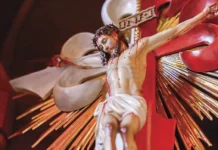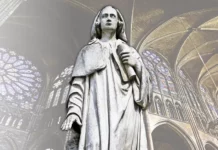Separated by a distance of 18 centuries, two spiritual diaries narrate two different ways of reaching the same objective: holiness.
After the death of Alexander the Great, in 323 BC, the vast empire he conquered was eventually split into four parts. The eastern regions went to the dominion of Seleucus Nicator, one of his most distinguished generals. Taking Babylon as a base, he swiftly built up the Seleucid Empire, encompassing a large area from the Mediterranean Sea to the Indus River. Antioch became its capital Around the year 300 BC.
Almost two and a half centuries later, in 64 BC, when the Romans conquered the Middle East, Antioch became the capital of the Roman province of Syria and the third most important city of the empire, only behind Rome and Alexandria.
In the time of Our Lord Jesus Christ, the city had close to 500 thousand inhabitants, including Syrians, Arameans, Jews and Greeks. The immense wall that surrounded it was protected by 300 towers. Powerful and beautiful, Antioch could take pride in being the main city of the region.

A child embraced by Jesus
The region of Palestine also comprises part of the territories that the Romans had added to their empire. Among the cities they conquered around the Sea of Galilee was Capernaum: a simple fishing village with houses built of large black stones. Our Lord did much of His work there.
On one occasion, returning from the Mount of the Transfiguration, Jesus came to the city with His Apostles and, knowing that they had argued among themselves as to who was the greatest, He asked them: “What were you discussing on the way?” (Mk 9:33). The best they could do was keep silent, for they were ashamed of themselves and their thoughts which had been so unfocussed on God, who was standing before them.
With adorable grandeur, Our Lord sat down and, calling the Twelve, He taught them: “If any one would be first, he must be last of all and servant of all” (Mk 9:35). And to add life to this teaching, transmitted on so many other occasions, the Divine Master put a child in the midst of the Apostles, embraced him and said: “Whoever receives one such child in My name receives Me; and whoever receives Me, receives not Me but Him who sent Me” (Mk 9:37).
This simple episode, which took place in a rustic fishing city, became the immortal example of humility and the paradigm for this virtue. And according to a beautiful tradition, the child who had the great privilege of being embraced by the Saviour became one of the greatest Saints of the apostolic era: Ignatius, Bishop of Antioch.
Innocence persecuted by villainy
This child, especially esteemed by Our Lord, became a follower of St. John the Apostle, the Beloved Disciple, and the second or third Bishop of Antioch, the city in which the followers of Christ were “for the first time called Christians” (Acts 11:26).
It was also in Antioch that St. Paul and St. Barnabas attained great success evangelizing pagans. And the first evangelizing missions would depart from this capital.
This was the site designated by Providence where St. Ignatius established a long and admirable government over the flock of the Church and exercised it until the Emperor Trajan, in the East, ordered ten soldiers to summon the venerable Bishop to Rome to the Flavian Amphitheatre, the famous Coliseum, to be martyred.
That innocent child, model of humility for the Apostles, would eventually be barbarously persecuted for being good, for being an authentic Catholic, for being a Saint! Innocence persecuted by villainy; gratuitous hatred of evil against the good.
Spiritual diary of a journey
In a time before the advent of rapid transportation, we can imagine the anguish of a person unjustly arrested, who trudges death’s road, heading toward an inevitably tragic end. Having access to a diary outlining the thoughts of such a person, especially if we knew he was a saint, would mean obtaining a true spiritual treatise.
This was the valuable legacy that St. Ignatius left us, for, in these very circumstances, he used the stops along the way to write letters to the various churches to whom he wished to counsel or address an exhortation.
Of the seven letters he wrote, and which are still extant, we are particularly interested in the one addressed to the Romans. Since the capital of the empire would be the place of his death, the holy Bishop dealt especially with the subject of martyrdom in this missive. It is the only one of his letters that is dated, written on August 24, probably in the year 107 AD, during a stopover of the soldiers in the port city of Smyrna.
Using metaphorical language, St. Ignatius reveals how his voyage was progressing: “From Syria even unto Rome I fight with beasts, both by land and sea, both by night and day, being bound to ten leopards, I mean a band of soldiers, who, when goodness is shown to them, show themselves all the worse.”1

“Allow me to become food for the wild beasts”
Shackled for love of Our Lord, the Saint affirms that the main reason for his writing to the Romans is to dissuade them from intervening in his judgement in an attempt to liberate him from the torments. This was precisely what he did not want: “I write to the churches, and impress on them all, that I shall willingly die for God, unless you hinder me. I beseech of you not to show an unseasonable good-will towards me.”2
How can a person fearlessly face death? St. Ignatius was fully aware of the torments he might have to undergo, but nothing distressed him as much as feeling far from his Divine Master: “Do not hinder me from living, do not wish to keep me in a state of death; and while I desire to belong to God, do not give me over to the world.”3
Indeed, his wish was heeded. In being devoured by the ferocious beasts, as he himself prophesied, his innocent soul once again encountered Him who had embraced him as a small child: “Allow me to become food for the wild beasts, through whose instrumentality it will be granted me to attain to God. I am the wheat of God, and let me be ground by the teeth of the wild beasts, that I may be found the pure bread of Christ.”4
The futile hatred of the Roman emperor is buried in history; the love of the venerable Bishop of Antioch, however, lives eternally with the Saviour. The grandeur of the Church of Christ overcame the powers of the time, showing who has true control over events: “Christianity, in being hated by the world, shows that it is not a work of persuasion, but of grandeur.”5 It is a grandeur that begins in the spirit of people like St. Ignatius and eventually influences and transforms all of society.
Another type of martyrdom
But not everyone has this same calibre of soul. Undoubtedly, very few have conserved their innocence as he did. At times we may lack courage – not to suffer martyrdom, but rather to overcome a sin or vice. This, paradoxically, sets in motion a veritable interior martyrdom, in which the beast that tears us apart lives inside us and is much fiercer than those of the Coliseum.
In the ancient Roman amphitheatres, those brave Catholics received the grace of martyrdom, standing firm for a few minutes while they were devoured by ravenous animals, and then their eyes opened to the eternal reality. With spiritual martyrdom, the victory always seems distant. The more one fights against the interior beast, the more invincible it seems.
How, then, can we attain holiness? The question becomes thorny if we consider that the person seeking holiness is one who has lost his innocence. He does not begin at the same starting point as St. Ignatius, but from a lower step, which makes the battle even more arduous.
Inner drama written on a wall of Rome
During the journey of a French journalist to Rome, in the mid-19th century, an unexpected find turned out to be a revelation about this type of spiritual martyrdom. The journalist, the famous Louis Veuillot, was walking through a deserted quarter of the Eternal City, when, on the outside wall of a church, he spied some well-defined characters etched with a charcoal pencil. It was the diary – faded by time – of the drama of a penitent soul.
It began like this: “September 14. I have health problems because of my own fault, caused by agitation and disobedience. At this moment, 11 o’clock in the morning, I decided, with the help of God and Mary Most Holy, to no longer torment myself and to recover true peace. St. Joseph, pray for me.”6
The anonymous hand of this pained soul had admitted an inability to dominate the interior beast. However, this person had taken the firm resolution to improve, with the help of God and Our Lady. He also invoked the venerable figure of the Patriarch of the Church, St. Joseph. If he took care of the Child Jesus, would he not also care for the members of the Mystical Body of His Divine Son?
What did this unknown martyr wish to say by agitation and disobedience? We do not know precisely, but this is not of great importance. For each us, the interior beast has a different name – pride, lust, avarice, envy, etc. – and, with God’s help, we must overcome it.
Failure and perseverance in resolutions
However, it often happens that just when the victory over the beast seems at hand, we feel, deep down, that which St. Paul himself describes to the Romans of his time: “For I do not do the good I want, but the evil I do not want is what I do” (Rom 7:19).
How often we make good resolutions and then, after a while, we notice that little or nothing of these resolutions have been fulfilled. With this, our spiritual drama intensifies; we must redouble our efforts to persevere in virtue, even at the cost of the “blood of our soul.”
The internal battle is admirably well described in the confession of this poor soul, who over the course of months, during the street’s deserted hours, left a register on that stone wall: October 14. Until now I have not managed to fulfil what I wrote on September 14; but now I have decided to do my utmost. November 15. I renew what I promised, so as to put it into practice. November 23. I have failed, but I have made the wholehearted resolution to do it. Today, December 28. I decided to be good. Today, December 31. I want to always obey, to please Mary Most Holy until death.”7
Who can fail to glimpse through these lines an intrepid spirit, even more so, in a sense, than that of a martyr? Incapable of obtaining victory alone, he turns and insistently implores Our Lady to triumph for him and in him! If the dilacerations of the body of the martyrs freed their souls to fly to God, in this instance, one must become emptied of self, placing oneself entirely in the immaculate hands of the Queen of Heaven.

Mary obtains for us the crown of victory
This was the foreseeable outcome of the story: whoever confides thus in Providence, through the intercession of the Virgin Mary, will certainly attain the victory desired.
The diary of our spiritual martyr continues: “January 28. By the love of Mary Most Holy there is no more agitation. And today, February 1, I renewed my resolution. March 12. The agitation is over. March 29. It no longer torments me and truly, I sin no more.”8
With the characteristic artistic flair of the Italian people, this victorious martyr expressed his contentment by drawing, on each of the last two inscriptions of his diary, two palms forming a crown. The crown of victory!
Reading the confessions of this trial-torn soul deeply touched Veuillot. To him they bore the fragrance of the inscriptions of the catacombs, where the first martyrs of Christ are buried.
The path to reach Heaven
In the same Rome where the innocent St. Ignatius of Antioch came out victorious by surrendering himself to the teeth of the beasts, we see, nearly 18 centuries later, a penitent soul triumph by freeing himself from the claws of the devil with Our Lady’s help.
The similarity between the two scenarios invites us to reflect on the immortality of the Holy Church. Centuries can pass, the devil can attack the Mystical Bride of Our Lord Jesus Christ, but the Blessed Virgin and the Patriarch of the Church never cease to help souls who sincerely wish to sanctify themselves.
Whether through innocence or penitence, there is only one way to reach Heaven: by conquering our “interior beast”, in the implacable battle to attain holiness. In this fight there is no place for hollow exterior postures; one must burn with charity and the desire to be reunited with God in eternity. Here, the counsel of St. Ignatius to the Romans fits well: “Do not speak of Jesus Christ, and yet set your desires on the world.”9 ◊
Notes







